| << Chapter < Page | Chapter >> Page > |
Each major key uses a different set of notes (its major scale ). In each major scale, however, the notes are arranged in the same major scale pattern and build the same types of chords that have the same relationships with each other. (See Beginning Harmonic Analysis for more on this.) So music that is in, for example, C major, will not sound significantly different from music that is in, say, D major. But music that is in D minor will have a different quality, because the notes in the minor scale follow a different pattern and so have different relationships with each other. Music in minor keys has a different sound and emotional feel, and develops differently harmonically. So you can't, for example, transpose a piece from C major to D minor (or even to C minor) without changing it a great deal. Music that is in a minor key is sometimes described as sounding more solemn, sad, mysterious, or ominous than music that is in a major key. To hear some simple examples in both major and minor keys, see Major Keys and Scales .
Minor scales sound different from major scales because they are based on a different pattern of intervals . Just as it did in major scales, starting the minor scale pattern on a different note will give you a different key signature , a different set of sharps or flats. The scale that is created by playing all the notes in a minor key signature is a natural minor scale . To create a natural minor scale, start on the tonic note and go up the scale using the interval pattern: whole step, half step, whole step, whole step, half step, whole step, whole step .

Listen to these minor scales.
For each note below, write a natural minor scale, one octave, ascending (going up) beginning on that note. If you need staff paper, you may print the staff paper PDF file.


Each minor key shares a key signature with a major key. A minor key is called the relative minor of the major key that has the same key signature. Even though they have the same key signature, a minor key and its relative major sound very different. They have different tonal centers , and each will feature melodies, harmonies, and chord progressions built around their (different) tonal centers. In fact, certain strategic accidentals are very useful in helping establish a strong tonal center in a minor key. These useful accidentals are featured in the melodic minor and harmonic minor scales.

It is easy to predict where the relative minor of a major key can be found. Notice that the pattern for minor scales overlaps the pattern for major scales. In other words, they are the same pattern starting in a different place. (If the patterns were very different, minor key signatures would not be the same as major key signatures.) The pattern for the minor scale starts a half step plus a whole step lower than the major scale pattern, so a relative minor is always three half steps lower than its relative major . For example, C minor has the same key signature as E flat major, since E flat is a minor third higher than C.

Notification Switch
Would you like to follow the 'Understanding basic music theory' conversation and receive update notifications?